
1st Cavalry, 2013; 28" x 40"

Angelita de los Artistas, 2014; 60" x 30"

Apache at the Pueblo, 2015; 20" x 16"
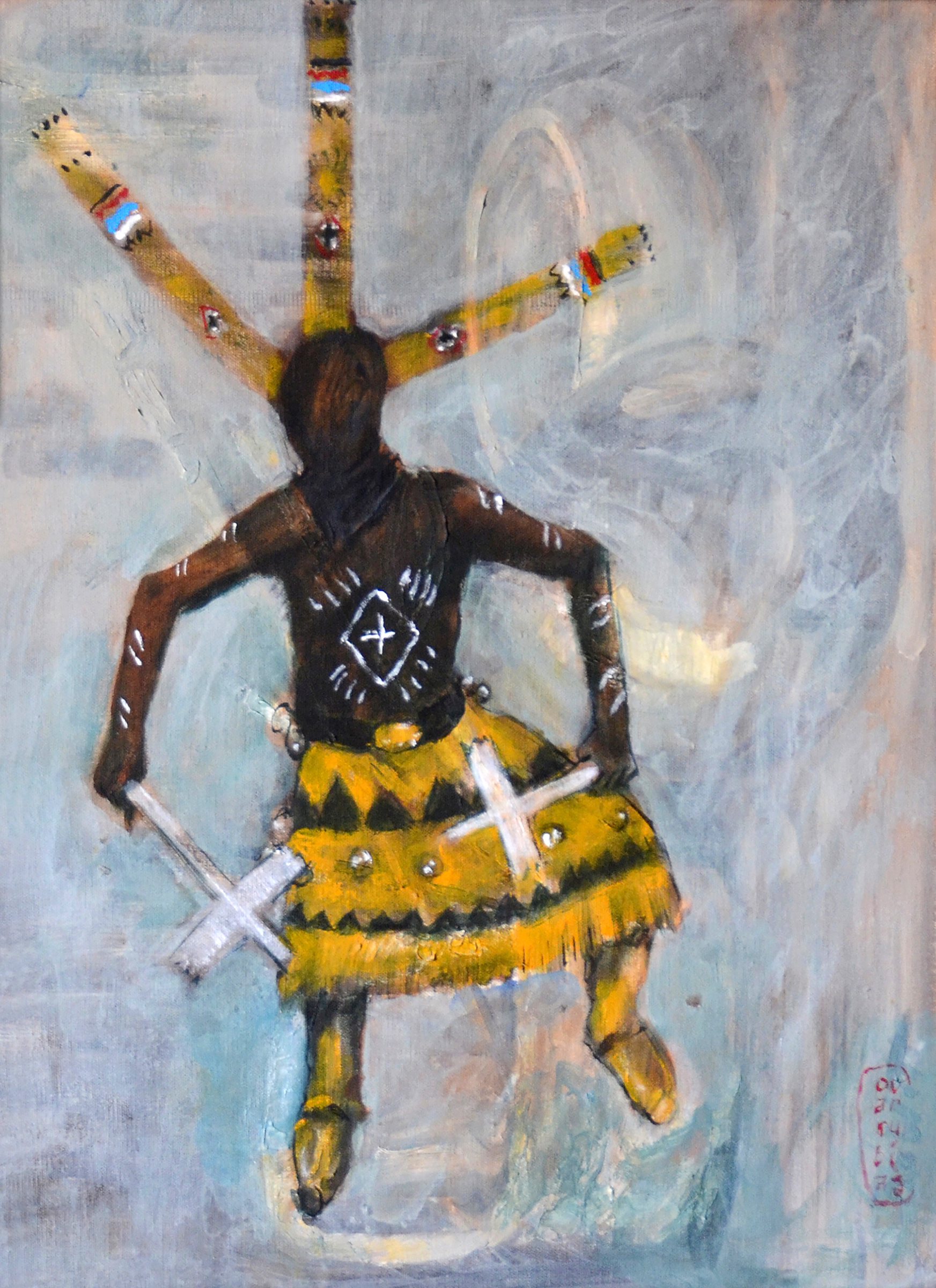
Apache Crown Dancer, 2011; 22" x 16"

Apache Ga'an Dancer, 2011; 48.5" x 49.75"
There are five dancers in the Apache Ga’an, or Crown, dance ceremonies. Four of the dancers are mountain spirits or spiritual ancestors that represent the cardinal directions, as well as lightning, clouds, rain, and snow. They each bring one of these natural blessings to the people (Inde”). The four dancers paint their bodies black and white and adorn themselves with lightning designs and animal motifs. The fifth dancer represents First Man (I’toi) honoring the ancestors and the original innocence of mankind. He is painted gray and plays the part of an unpredictable clown who is a messenger between the Apache and the Spirit People.
Traditionally, the dance would last four days as a healing ceremony to evoke blessings and ward off evil for the community. The sacred belief is that the Creator sends the Ga'an to guide the people, teaching them the path to a harmonious life with each other and the land. Often, tribal makers and artists carve Kachinas of the Ga’an from cottonwood or saguaro. Personal experiences with the traditions, photographs, or sculptures by other artists inspire Jim's paintings of ceremonial characters.

Autumn, 2015; 48" x 60"

Bear Clan Fetish Effigy, 2005; 36" x 48"

Bird of Paradise, 2005; 48" x 48"

Blue Holiday, 2014; 14" x 11"

Butterfly Dance, 2012; 60" x 48"

Cactus Flower, 2006; 48" x 48"

Cactus Flower, 2005; 36" x 36"

Carbajal Silences the Bazooka, 1990; 48" x 48"

Cesar Chavez, 1999; 48" x 48"

Chanupa (Sacred Pipe), 2014; 37.5" x 29"
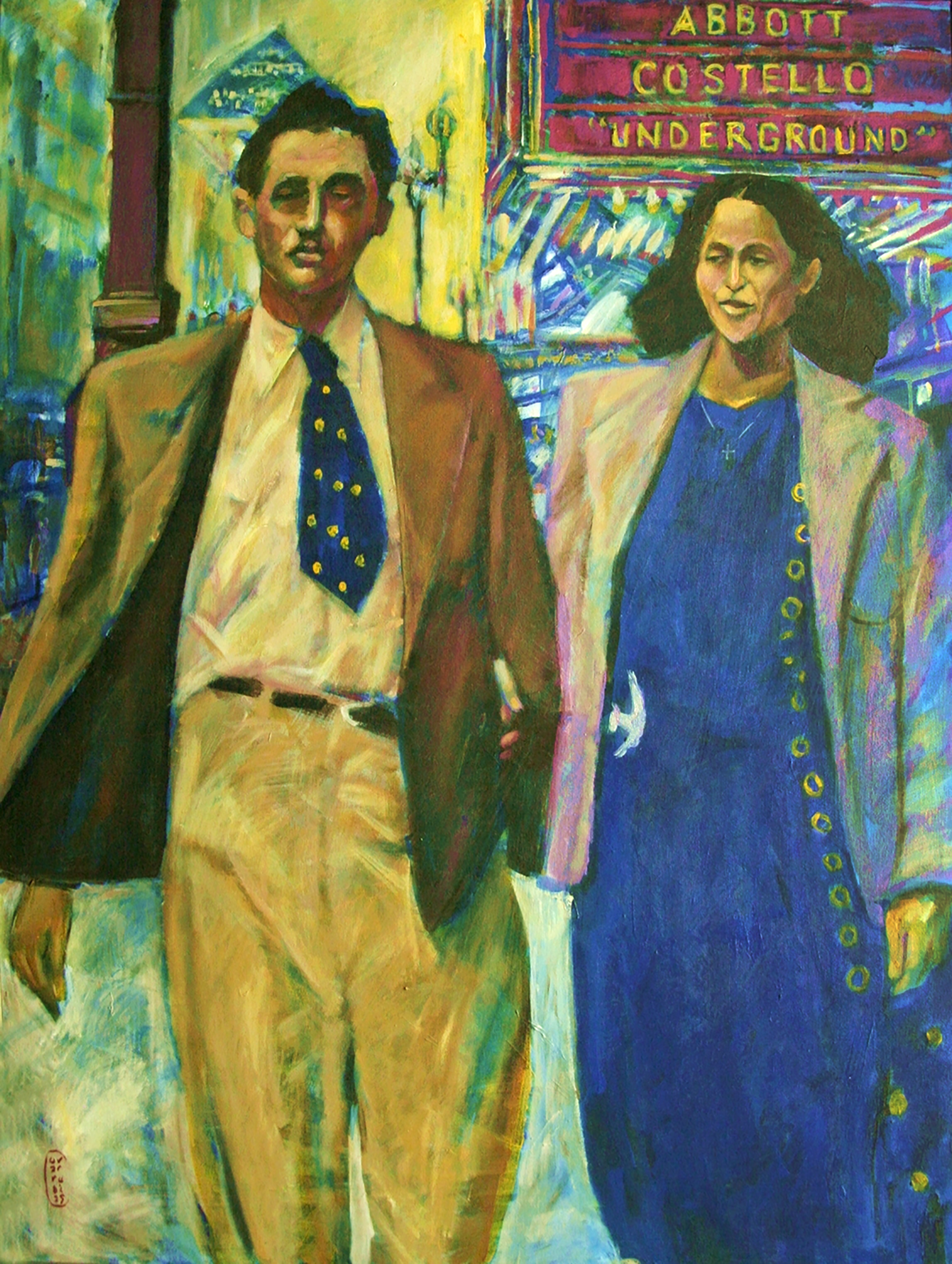
Chapito Chavarria, 2014; 49.75" x 37.5"
An homage to the legendary Latino Big Band leader, Rafael "Chapito" Chavarria, an Arizona native, World War II Veteran, ASU Alumni, and musical genius whose career began before WWII and kept swinging until 2015. He lived to be 100 years old and was part of thousands of Latinos lives who remember him and his band at their wedding, Quinciniera, birthday and holiday celebrations at American Legion Post 41, Riverside Ballroom, and the Calderon Ballroom in Phoenix. For four decades beginning in the late 1940s, Chavarria was the top draw in the Valley's Latino music scene! He knew what audiences wanted, and he pleased the people, his key was that he was one of them. The people he played for were his friends, neighbors, co-workers. Mid-century Phoenix was highly segregated to the point that it had the nickname, "The Alabama of the Southwest," so the Latino community was very tight-knit and internally supportive.
Much of his sound resembles Sonora Santanera, an influential Mexican big band with brassy rhythms, but his songbook consisted of Mexican and Cuban boleros, mambos, cha-chas, and rancheras mixed with American songs and crossover tunes. In 2014, Chavarria was honored with a sold out tribute concert and exhibition at the Musical Instrument Museum in Phoenix.

Cherokee Love Song, 2005; 48" x 36"

Cheyenne, 1989; 50" x 70"

Cinco de Mayo, 2003; 36" x 48"
In 1862, the French Foreign Legion arrived at the city walls of Puebla, Mexico. They were to siege the town. Benito Juarez, President-elect of Mexico, a full-blooded Zapotec Indian, sent young general Zaragoza, a 28-year-old graduate of the prestigious Chapultepec Military Academy, the West Point of Mexico and a Cavalry Brigade to check the French. They were joined by townsfolk militia and natives from the area (Opata and Otomi). They charged out of Puebla the morning of May 5 and began a hand to hand battle with the surprised French who had just arrived the day before and were still setting up their siege cannons. The vicious fighting raged for 4 hours, and then the French bid a hasty adieu to Zaragosa led troops and the hornet’s nest they marched into. Two of Zaragosa's lieutenants would later be Presidents of Mexico.

Crow Mother Kachina, 2001; 40" x 30"

Deer Dancer, 2004; 38" x 46"

Desert Abstract, 2014; 49" x 96"

Dimitri Drobatschewsky, 2005; 36" x 40"

El Sol, 1999; 48" x 60"

Frida Con Pistola, 2015; 36" x 60"
36" x 60"

Georgia O'Keefe, 1996; 60" x 48"

Geronimo Planning the Raid, 2014; 20" x 24"

Geronimo, 1997; 36" x 48"

Golden Holiday, 2014; 24" x 18"

Hastin Acanti Badanie, 2012; 20" x 16"

Hopi Dancers, 2013; 35.5" x 24"

Hopi Girl, 2014; 48" x 36"

Hwal'a Bay Eagle, 2015; 30" x 42"
This Grand Canyon rock formation is directly across from the Hualapai Nation’s spectacular tourist destination, the Sky Walk, a vertigo challenging walk onto a glass bottomed lookout 4000 feet above the Colorado River in the western canyon. The painting was created directly from a photograph by Arizona Veteran's Magazine photographer Dana Sill. He photographed it during a trip hosted by the Hualapai Nation, including Jim's long time friends Philbert Watahomigie, Joel Querta, and Michael Whatoname. That Veteran’s Day, Jim and Congressman Duncan Hunter were guest speakers for festivities on the Hualapai Reservation.

I Have A Dream, 2015; 36" x 52"

James Dean, 2013; 60" x 48"

Jim Thorpe, 2008; 30" x 48"

Lunar Eclipse, 1998; 48" x 60"

La Leyenda Emiliano Zapata, 2014; 60" x 48"
Emiliano Zapata was a legendary leader of the Mexican Revolution (1910-1920) and one of the foremost leaders of the agrarian movement in southern Mexico during the struggle. Zapata, a full-blooded Zapotec Indian, was a charismatic figure in the peasant revolution against wealthy land "owners" given property by the corrupt government. His fight for the people was so ingrained that many referred to the movement as Zapatismo in the southern Mexican states, including his home in Morelos. He formed the Liberation Army of the South and used his equine skills (he was previously a famous horse trainer for previous Mexican Presidents) to defeat the Federal troops. Like Pancho Villa, Zapata rode victoriously into Mexico City and later declined the offer to be President of Mexico. He returned to his home in Morelos but later assassinated by agents of the corrupt government. Zapata is forever remembered for his noble sacrifice for the people of Mexico.

Magical Warrior, 2000; 48" x 36"
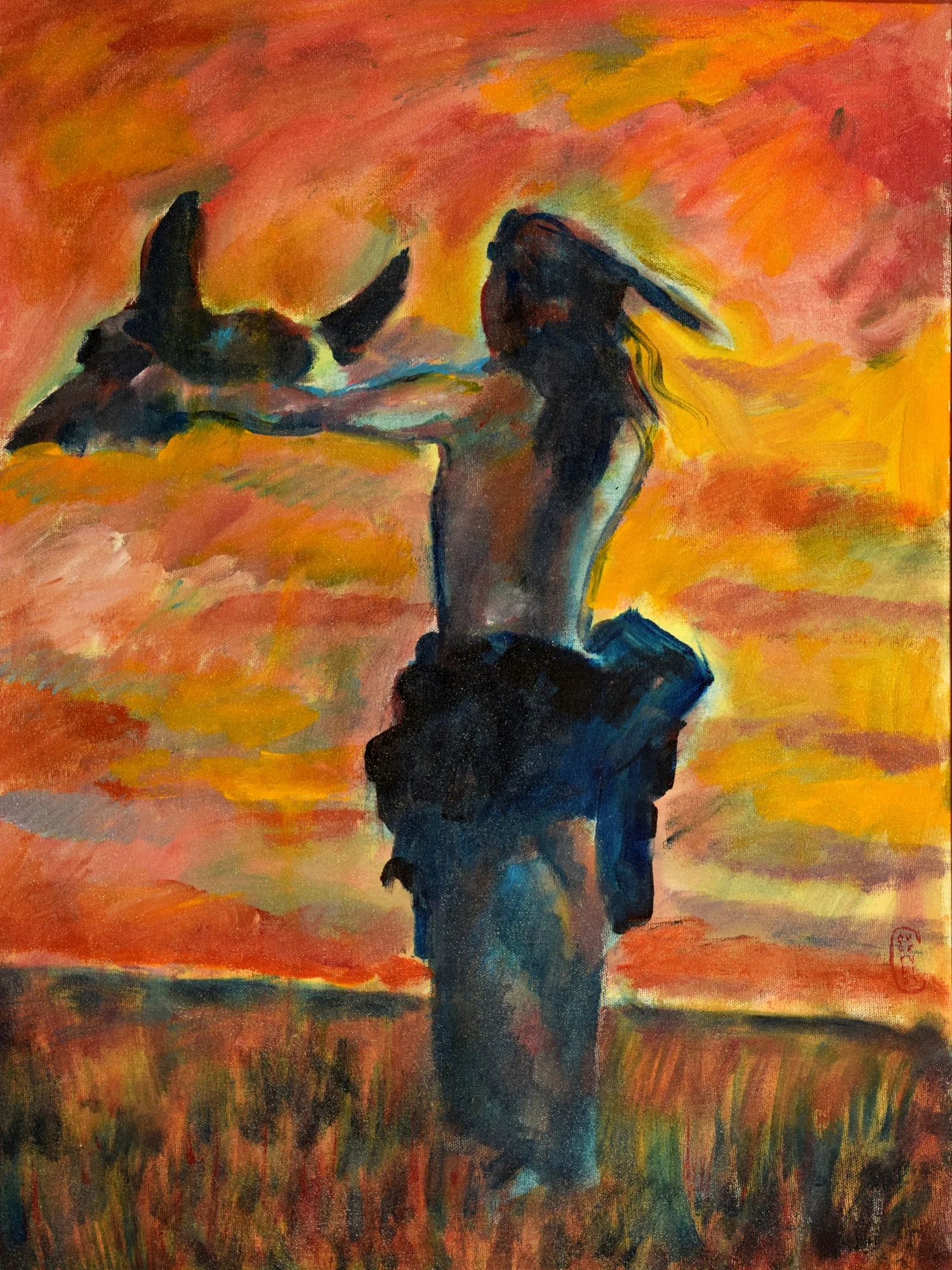
Mandan, 2011; 24" x 18"

Maria Felix, 2010; 49" x 47"

Me and Philip C Curtis, 1990; 48" x 48"
Philip C. Curtis is an Arizona treasure. He is one of the state's most famous and most collected artists. Originally from Michigan, Philip went to Yale on his father's urging to study law, but when he arrived he told them he wanted to be an artist. But, Yale did not have an art department at the time, so he started it! Later, when he arrived in Phoenix, there was no art museum, so Philip worked with banker Walter Bimson to found the Phoenix Art Museum, which still houses an extraordinary collection of his paintings. Philip was a Surrealist whose haunting visions set Victorian types in lonely, desolate desert, and deserted scenes.
This painting is from a photograph taken in Joseph Sanchez's studio in Scottsdale. Philip was a dapper, affable gentleman who loved art, women, and a stiff cocktail. Jim fondly reflects on his times hanging out with Joseph and Philip, drinking wine, sharing serious and not so serious reflections on life, women, war, etc. In World War II Philip and fellow artists including Bill Blass and Howard Laynor were in the CIA and built a "fake" army in Scotland fooling the Nazi's into thinking the European invasion would come from the north.

Mexica, 2012; 12" x 9"

Mexicana, 2002; 51" x 51"

Miguel Y Rosa, 1999; 43" x 77.5"
This painting is an homage to Jim's great uncle Miquel and aunt Rosa Rolinda Covarrubias from a photograph taken by the famous Edward Weston. Miguel was an illustrator, anthropologist, collector, humorist, curator, devoted son, and a true renaissance man whose fame flashed like a comet. His story is forever linked to Mexico, where he reached into the rich cultural history and pulled out of its beating heart the pulsating oldest culture, the Olmec! He and his gracious, beautiful wife Rosa, artist, dancer, movie star, and culinary chef gave the best dinner parties to the cultural literati of the 30s and 40s. Among their many friends were Diego Rivero and Frida Kahlo, Edward G Robinson, Tyrone Power, Nelson Rockefeller, Catinflas, Josephine Baker, John Huston, Nicolas Murray, Dolores Del Rio, Luis Barragan, Georgia O’Keefe, Rufino Tomayo- just to mention a few.
Deft lines of sensitivity echo the beauty of humanity
Gifted with creativity, inspired by genius divine
Your lives lovingly intertwined
This legendary tale of love and art
Will forever inspire the palette and the heart.

Mohave Girl, 1998; 71" x 51"

Nambe, 1998; 60" x 48"

Orme Dugas, 1981; 48" x 48"

Pat Tillman, 2014; 14" x 11"

Rosa Rolanda Covarrubias, 2005; 48" x 34"

Sacred Colors (Four Fridas), 2009; 48"x48"
An homage to Frida Kahlo as a Mexican icon of modern art, showing all of her sides and diversity. She was a complicated and intense woman, so Jim felt that one simple portrait just would not do her justice. Instead, he decided to show Frida in the four stages of her life here defined in sacred Uto-Aztecan colors, which also relate to the cardinal directions. This aspect of the painting is for Frida's mother, a native Zapoteca (her father was a Russian Jew, who immigrated to Mexico to escape oppression), part of this vast language group originating in North America and invading Central America, ruling the central highlands for at least a thousand years after the Toltecs.
Starting at the bottom right:
Yellow Frida, here shown as an Indian, her heritage on her mother's side. Representing the East and the beginning, birth, and Judea in Jewish ideology, the land chosen by the Creator.
Blue Frida, portrayed as a Jewish youth representing her father’s ancestry. Blue signifies the South, adolescence, and Tolteca, the native land of the people at one with the Creator.
Red Frida, seen as an adult Mestiza, or mixed European and Mexican. Symbolizing the West, maturity, and the Mexicana, gifted by the Creator.
Green Frida, expressed as a spirit. She stands for the North as a Leyenda, or legend, chosen by the people.
Further, the four cardinal directions embody the Sacred Circle of Life:
Love - Respect - Discipline - Wisdom

Self Portrait, 1994; 68" x 50"

Shaman, 2011; 48" x 48"

Six Directions, 2005; 36" x 58.5"

Sky People, 1998; 48" x 62"

Song of Kokopelli, 2015; 60" x 48"

The Gold Door, 1998; 48" x 48"

The Race, 2011; 18" x 24"

The Guardian, 2005; 48" x 48"

The Patriot, 2015; 40" x 30"
In Honor of all Veterans who fight for the freedoms we enjoy every day, and the struggles we continue to battle. A Minuteman, those first soldiers of yet to be America, armed with musket and Indian tomahawk. They were hardy frontiersmen whose fighting skills were honed against the great Native Americans, preparing them for the fight against King Henry’s Redcoats. The founding militias were also allied with many loyal tribes whose story will ever be linked with bravery and gallant deeds helping to form this great country.

Tom Chauncey's Ranch, 1981; 31" x 48"
Just off the Orme Dugas turnoff on the road to Flagstaff, this picturesque setting is along the Agua Fria River, in an elegant Cottonwood Grove in the high desert watching over a shady glen. Jim painted this on-site, in front of a youth group class of inner-city kids attending a summer camp with art classes sponsored by Chicanos por La Causa. Tom Chauncey, the owner of Channel 10 in Phoenix, offers his ranch to programs helping and educating our youth. This natural escape is a perfect shady, cool place and one of Jim's favorites to paint in the open air. Just off the Orme Dugas turnoff on the road to Flagstaff, this picturesque setting is along the Agua Fria River, in an elegant Cottonwood Grove in the high desert watching over a shady glen. Jim painted this on-site, in front of a youth group class of inner-city kids attending a summer camp with art classes sponsored by Chicanos por La Causa. Tom Chauncey, the owner of Channel 10 in Phoenix, offers his ranch to programs helping and educating our youth. This natural escape is a perfect shady, cool place and one of Jim's favorites to paint in the open air.

Tonantzin, 2014; 48" x 60"

Vietnamese Ranger Comforting a Child, 2013; 20" x 16"

Vision Quest, 1998; 55.25" x 70.75"
In some Native American cultures, young males entering adulthood undertake a vision quest as a rite of passage. This type of rite usually consists of a series of ceremonies, fasting, and spending time alone in nature or at a sacred site. The young person would pray to the spirits for a vision to help them find their purpose or role in the world and their community. Usually interpreted by an elder, the vision would lead them into adulthood and guide their future experiences.
Running you pray
Fasting you pray
Dreaming you pray
Sweatlodge you pray
On the mountain you're alone
You see your family
Those who have passed
Pangs of guilt and regret grip the pit of your stomach
You suffer from hunger, thirst, fear and doubt
You are lost, blind and exhausted
You see a light, it washes over you
Your spirit is free and lite
The Good Red Road is before you
You are Oyate Lute!
People of the Chanupah!
You walk on the Good Red Road!
Ho-kah-hey!

Wapiti, 1995; 34" x 34"

Warrior, 1996; 48" x 48"

Winter, 1998; 48" x 48"

Wild Horses, 2010; 36" x 40"

Y Que!, 2015; 48.5" x 37

Zanjero, 2008; 24" x 36"

Ballplayer in 1250 AD, 2016

Blessings of the Storm, 2016
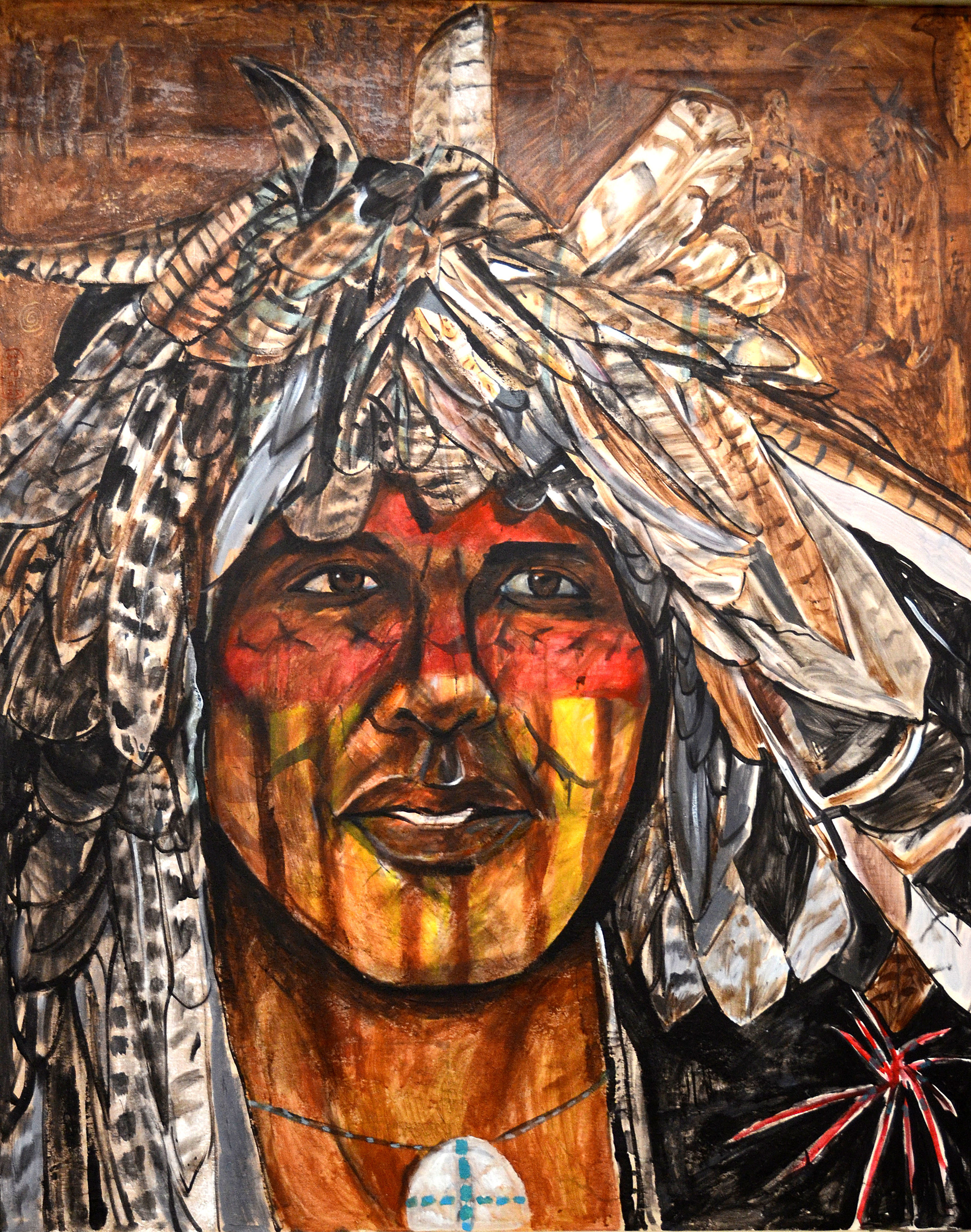
Kokopelli's Vision, 2016

Migration South, 2016

Prayer at Rio Salado, 2016

Seeking the Vision, 2016
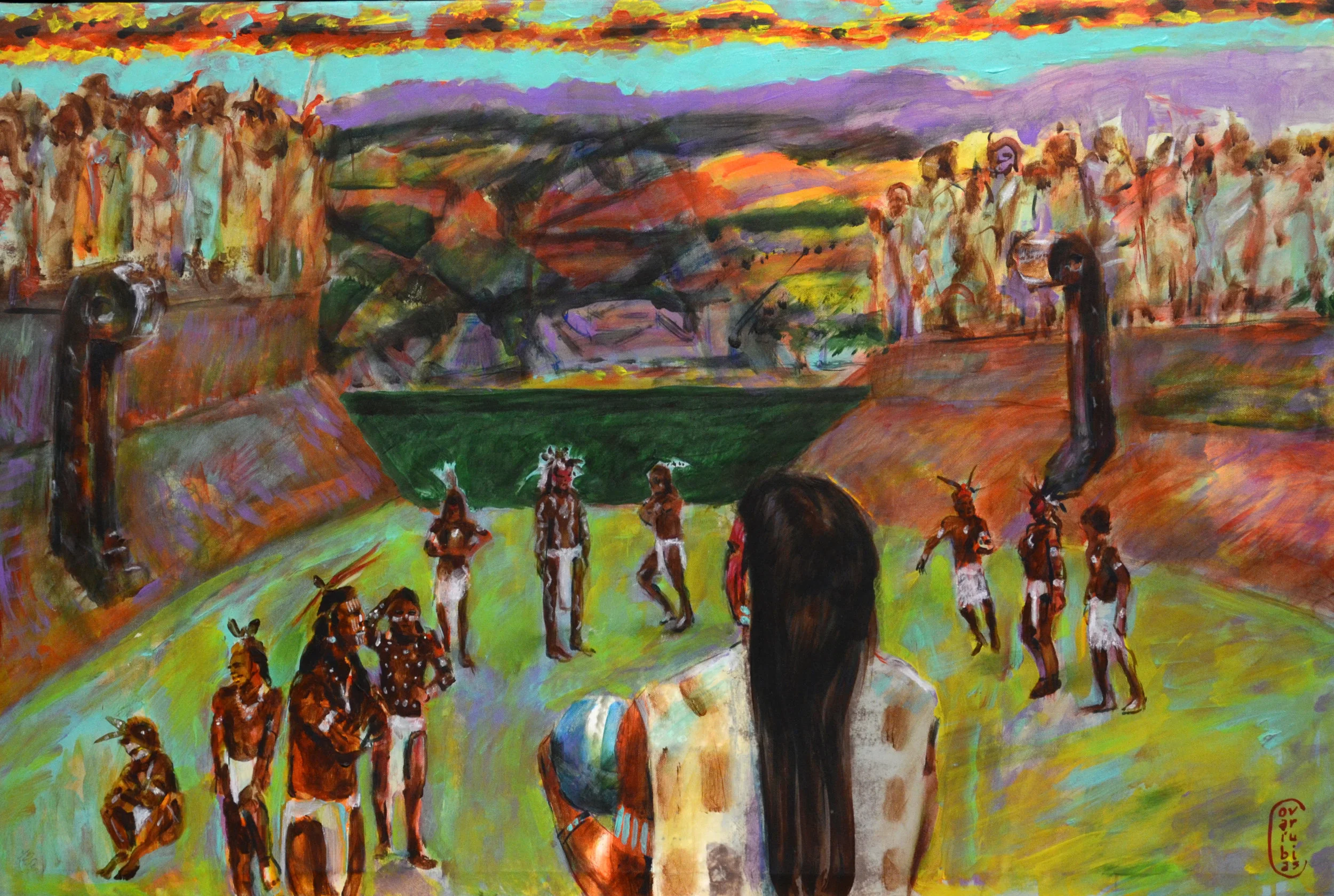
Tonantzin, 2016

Frida Kahlo Peinando a Rosa Covarrubias en El Estudio de Diego Rivera, 2016

La Mesa de Rosa, 2017

Miguel Covarrubias en Son Estudio, 2016

Miguel y Rosa en su Casa, 2017

Miguel y Rosaa en Tortuga

El Miguelito, 2016

Rosa & Seamstress, 2016

Rosa Con Jarron en la Cabeza

Rosa con personilidades de la Communidad de Chinois y Dolores del Rio, 2016

Rosa Covarrubias 1920, 2016

Rosa Covarrubias

Rosa Covarrubias, 2016

Rosa en el Estudio en su Casa, 2016

Rosa en el Istmo de Tehuantepec, 2016

Rosa en el Istmo de Tehuantepec, 2016

Rosa en su faceta de modelo del Autor, 2016

Rosa pensando a Van Gogh, 2016

Rosa Roland Covarrubias, 2016

Rosa sentada en el Corredor de una Casa Balinesa, 2016

Rosa y Tyrone, 2016
































































































